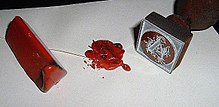Black Chamber
The black chamber (also: Schwarzes Kabinett ; older spelling Schwarzes Cabinet ; English Black room ; also: Black chamber ; French Cabinet noir ) was the name given to the place set up at important post offices, where all by one person by order of the state government or another power Outgoing or incoming letters were secretly opened, inspected, copied, resealed and returned to the postal service.
The oldest institution of this type is said to have been in France under King Louis XI. (1423-1483). On the basis of an edict of June 19, 1464, the French State Post had to create such an institution. However, this edict was exposed in 1937 by Gaston Zeller as a forgery from the 17th century.
Initially, the black chambers were only used for state purposes. Couriers and postillons were obliged to look through the letters handed over to them privately for messages that were harmful to the king.
In the case of the Imperial Post Office operated by the Thurn und Taxis , such secret lodges can be found in many cities up to the beginning of the 19th century. In 1808 the Bavarian government found out about it and thus justified the nationalization of Taxis' post office.
Institutions of a similar nature ( letter censorship ) violating the secrecy of letters were common in times of war and during the occupation. In 1809, under Napoleon , the French created a cabinet noir in the occupied Prussian capital Berlin. In the course of time, the black chambers also increasingly faced the task of deciphering encrypted messages. The best known and one of the most efficient black chambers was the Secret Cabinet Chancellery in Vienna.
As a result of the political upheaval in Europe, the black chambers were dissolved in England in 1844 (see also: Pre-Victorian reforms ), in Paris in the revolutionary year of 1848 , and in Vienna in the same year, during the revolution of 1848/1849 in the Empire Austria .
literature
- Archive for Postal History in Bavaria. Published by the Society for Research into Postal History in Bavaria in conjunction with the OPD Munich (1925: p. 68, 1935: p. 185 ff.), Deutsche Verkehrs-Zeitung (1931: p. 894 ff.), L'Union Postale (1935: p. 381)
- Friedrich L. Bauer : Deciphered Secrets. Methods and maxims of cryptology. 3rd, revised and expanded edition. Springer, Berlin a. a. 2000, ISBN 3-540-67931-6 .
- Klaus Beyrer: The Post Office's black cabinets. In: Wilhelm Haefs, York-Gothart Mix (Hrsg.): Censorship in the century of the Enlightenment. Wallstein Verlag, Göttingen 2007, pp. 45–59.
- Siegfried Beer: The intelligence services in the Habsburg monarchy . 2007, bmi.gv.at (PDF; 1.1 MB) accessed May 28, 2015
- Handheld dictionary of postal services . 2nd completely reworked edition. Federal Ministry for the Post and Telecommunications , Frankfurt am Main, 1953, pp. 670–671.
- Today: The state takes over the Taxis Reichsposten in Bavaria . Hugo Schmidt, Munich 1925
- David Kahn: The Code Breakers - The Story of Secret Writing . Macmillan USA, Reissue 1974, ISBN 0-02-560460-0
- Manfred Klotz: Stenography in the Black Cabinet . In: Neue Stenografische Praxis , 60/1, 2012, pp. 1–12.
- BE König: Black Cabinets. Luckhardt Berlin-Leipzig 1899
- Schweiger-Lerchenfeld: The new book from the Universal Mail . A. Hartlebens Verlag, Vienna 1901, p. 376
- Simon Singh : Secret Messages . Carl Hanser Verlag, Munich 2000, ISBN 3-446-19873-3 .
- Fred B. Wrixon: Codes, Ciphers & Other Secret Languages - From Egyptian Hieroglyphics to Computer Cryptology . Könemann, Cologne 2000, ISBN 3-8290-3888-7
- The black cabinet . In: The Gazebo . Issue 40, 1863, pp. 631–632 ( full text [ Wikisource ]).
- The black cabinet . In: Deutscher Hausschatz , 1911 ( Wikisource )
Web links
- The history of the mail opening , accessed on May 28, 2015.
- Black Chambers , accessed May 28, 2015.
Individual evidence
- ↑ Simon Singh: Secret Messages . Carl Hanser Verlag, Munich 2000, ISBN 3-446-19873-3 , pp. 81-86.
- ↑ Wolfgang Behringer: In the sign of Mercury . Vandenhoeck & Ruprecht, Göttingen 2003, ISBN 3-525-35187-9 , pp. 58 and 779 with reference to Gaston Zeller: Un faux du XVII siècle: L'édit de Louis XI sur la poste . In: Revue Historique , 180, 1937, pp. 286–292.
- ↑ Friedrich L. Bauer: Deciphered secrets. Methods and maxims of cryptology. 3rd, revised and expanded edition. Springer, Berlin a. a. 2000, p. 75.
